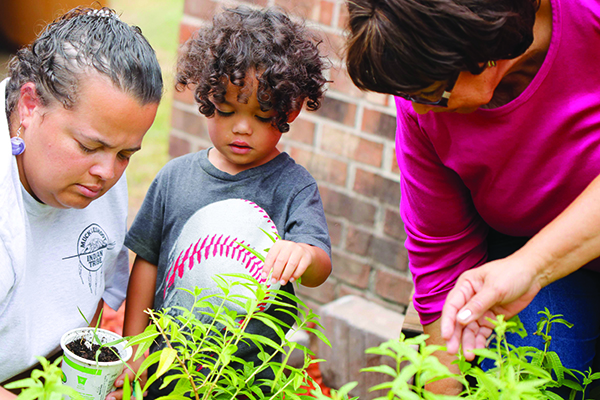by Emily Oglesby, NCBG Communications & Exhibits Coordinator
Anyone who has felt the mouth-puckering astringency of an unripe persimmon knows there’s an art to harvesting wild native foods.
The expertise required to spot a sweet-as-candy persimmon or harvest cattail fronds for mattress filling has existed for countless generations in Native communities. But as work has moved indoors and onto computers – as even farming has become mechanized – interest in plants has waned.
Tracie Locklear, a natural products researcher at North Carolina Central University and member of the Lumbee and Coharie Tribes, wanted to bridge the gap between traditional knowledge and an increasingly disconnected modern lifestyle. “I wanted to go back,” she says. “As country kids, during the summers we would work in the fields. In my family, we’d pick peas and corn and cucumbers and watermelons, and there was this rich lifestyle that I didn’t feel our children still had access to.”
Locklear began talking to elders in North Carolina Native communities and found there was significant interest in delving into their connections with the land – their memories of wild food plants, native medicinal plants, and old recipes and traditions. Inspired, she started the North Carolina Native Ethnobotany Project (NCNEP) last year in collaboration with Jillian de Gezelle, ethnobotanist at North Carolina State University, Randi Byrd, community engagement coordinator at the UNC American Indian Center, and community advisory board members from participating tribes. Project volunteers conduct focus groups and interviews with community elders about their memories and knowledge of native plants, collect plant specimens for cataloging, and return knowledge back to communities through workshops.
What was initially meant to be a pilot project with a few North Carolina tribes – the Coharie, Waccamaw Siouan, and Haliwa-Saponi – has sparked new community projects and a forthcoming book highlighting around 70 species of plants those communities want to regain access to and restore to their landscapes and gardens.
“It’s brought us back into contact with our native plants that our people have used,” says Darlene Graham, NCNEP community advisory board member and active member of the Waccamaw Siouan tribe. Native plants like black walnut, wild cherry, American persimmon, sassafras, and elderberry, and culturally significant introduced species like sorghum, black-eyed peas, and collards. All have a rich history in Native communities.
· · · ·
Randi Byrd scanned roadsides for the tell-tale black clusters of elderberry fruit on her way to Buckhead, home of the Waccamaw Siouan community. She collected some berries from plants she spotted. Sure enough, community members had been looking for some – excitement around elderberry has been building. Elderberry (Sambucus canadensis) is a native shrub that produces big clusters of white flowers in late spring that give way to fruits some consider a superfood for their immune-boosting properties – high levels of Vitamin C, flavonoids, and anthocyanins. Hands-on workshops creating elderberry syrup with the fruits and additional aromatic spices have been a big hit. And the proof is in the pudding: Byrd hasn’t gotten a cold once since she began her daily elderberry syrup regimen.
In the Haliwa-Saponi community in northeastern North Carolina, Linwood Watson has seen a renewed interest in the American persimmon trees (Diospyros virginiana) that pepper the tribe’s land. Watson is a member of the Haliwa-Saponi tribe and serves on the NCNEP community advisory board. “You can sense a lot more interest in letting the young people know the tree is there – making sure they know how the fruit of the tree will come off, knowing the proper time to harvest and prepare it,” he says. “You’ve got to be connected to the seasons – it makes you appreciate the whole process much more.” Baking a persimmon-nut loaf (in the style of banana bread) silenced skeptics. “People were like, ‘I knew you could eat it, but I didn’t know you could fashion it into something that good!’” says Watson.
The project has inspired community members in the Waccamaw Siouan tribe to build a healing green space that will feature native plants and herbs used traditionally by their elders and serve as a social, educational, and productive resource for the community.
But the intangible results may be more significant: the process of coming together around food, natural heritage, and a shared history has been a source of joy and healing. As they meet for talking circles about plants, discussions have brought back childhood memories to elders. “Their faces just lit up: ‘Oh yeah, we used that! I remember!’” says Graham. “The project has brought us together through intergenerational gatherings, talking circles. Elders have been able to teach the young people; that’s brought a lot of joy to them.”
Byrd says she’s seen a change in mentality within the participating communities: a different way of seeing the world, a rekindling of the way their ancestors saw their natural resources. Participants are asking, “How can we let nature work with and for us, and how can we work with and for nature?” And they’re finding an increased appreciation for the beauty of what’s already here – the rich biodiversity of native plant communities.
The project raises universal questions about what it means to live in harmony with the environment. As Watson puts it, “We still have these natural gifts. What can we learn from them as their stewards; what can we demand of ourselves as their caretakers?”
Learn more about the NC Native Ethnobotany project at ncnativeethnobotany.org.
Photo by Darlene Graham
